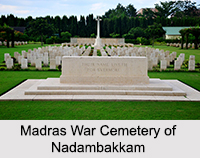 Nandambakkam is situated south-west of Chennai at a distance of 13 km on the Mount-Poonamalle Road and is known to be a town in the Alandur taluk. The town is bound by Alandur and St Thomas Mount on the east and Manapakkam to the west. To the north and north-west, Nandambakkam is bound by Ramapuram and to the south by Pallavarama. The township extends from the Madras War Cemetery to the east, to the banks of the Adyar River on the west. Located at an elevation of about 69 ft, the official language spoken here is Tamil.
Nandambakkam is situated south-west of Chennai at a distance of 13 km on the Mount-Poonamalle Road and is known to be a town in the Alandur taluk. The town is bound by Alandur and St Thomas Mount on the east and Manapakkam to the west. To the north and north-west, Nandambakkam is bound by Ramapuram and to the south by Pallavarama. The township extends from the Madras War Cemetery to the east, to the banks of the Adyar River on the west. Located at an elevation of about 69 ft, the official language spoken here is Tamil.
Demographics of Nandambakkam
As per the reports of Census India 2011, the total population of Nandambakkam is 11,239 out of which 5,561 are males and 5,678 are females. The population of children between the ages 0 to 6 is 1207 which is 10.74% of the total population. The female sex ratio is 1021 which is higher than the state average of 996. The literacy rate of Nadambakkam is 92% higher than the state average of 80%. The male and female literacy rates are 95.57% and 88.41% respectively.
History of Nandambakkam
The ancient history of Nandambakkam town dates back to the medieval period of Ramayana, when an ancient sage named Bringi Rishi was doing penance from a hill nearby to the city. He resided on that hill for several years, which in turn got the hill its name as Bringi Malai. The name was later changed to Parangi Malai which is currently known as the St.Thomas Mount. It is said that Lord Rama was once passing through the area and Bringi Rishi invited him as a guest to stay there for a few days. Lord Rama obliged his request and the sage created a small garden or a Nandhavanam for the comfort of the Lord. This garden later came to be known as Nandhambakkam and its neighbouring place is Ramapuram, which is said to have got its name after Lord Rama"s stay there.
Since India`s independence in 1947 Nandambakkam has been in existence as a part of the Chingleput district. In the year 1948 a decision was taken to impart training in hand weaving activities. The town"s growth dates back to the post independence era, during the 1950s and early 60s when a number of social welfare schemes were launched. In 1952, the Madras War Cemetery was constructed in the eastern fringes of Nandambakkam. Under the administration of erstwhile Chief Minister K. Kamaraj, a proposal for establishing a surgical instruments factory at Nandambakkam with Russian collaboration was undertaken by the Indian Drugs and Pharmaceuticals Limited. This culminated in the inauguration of the factory on 1st September, 1965, which was constructed at the cost of Rs.52.5 million and was expected to manufacture 2.5 million pieces of surgical instruments. The surgical instruments plant was later named IDPL, but from 1994 the production of surgical instruments has totally stopped and a major portion of the factory has been closed. On January, 2001, the India Trade Promotion Organisation also commonly known as the Chennai Trade Centre was inaugurated at Nandambakkam. The trade centre spreads over an area of 25 acres and was created as a joint venture between the ITPPO and the Tamil Nadu Development Corporation (TIDCO) to conduct trade fairs in the city.
Visiting Information on Nandambakkam
The Chennai Central Railway station is the nearest to the town at a distance of about 13 km. While the closest airport to the Nandambakkam is the Chennai International Airport at a mere distance of 16 km.



















